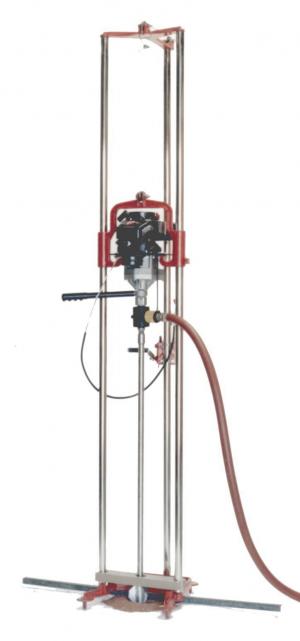2001 - Volume #25, Issue #2, Page #19
[ Sample Stories From This Issue | List of All Stories In This Issue | Print this story
| Read this issue]
Do-It-Yourself Well Drilling
 |
 |
DeepRock is best known for its commercial well drilling equipment, but several years ago they recognized the need for something smaller and more portable. That's when they developed the HydraDrill.
Chris Lackey, marketing manager for HydraDrill, notes that most people spend $3,000 to $5,000 to have a well drilled.
"They can buy a HydraDrill and drill their own and maybe several for themselves or neighbors and then sell the used drill when they're through," he says. "That makes a lot of sense to people who have had to have two or three deep holes drilled in order to find water."
Lackey tells of a Nevada customer who had a commercial driller try to find water only to give up after several deep, dry holes. "He bought a HydraDrill and put in his own well," he says. "He found 30 gal. per minute at only 65 ft., which was more than enough to supply his livestock."
"It works just like any other mud-type rotary drilling machine," Roach explains. "It needs water and a śmud pump' that carries water and dirt away from the hole.
The drill is powered by a 4 or 6 hp 4-cycle single cylinder engine with a clutch and an 18:1 gearbox that turns the drill at about 170 rpm's.
Lackey says one person can set up and operate the HydraDrill with no problems, but notes that it's faster with two. "Under ideal conditions, it's a good weekend job to put in a well if you have no drilling experience," he says.
"If you're drilling through rock or through collapsing formations, it may take longer," he adds. "But we have optional bits, special instructions and Toll-Free technical assistance to help our customers drill in these formations."
One of the good things about the HydraDrill is if it takes a little longer or the well needs to be deeper, you're not paying extra for the driller's time and machinery.
"The drill bits, well casing, and drilling additives are the only expendable part of this system," says Roach. "Everything else can be used over and over."
Actually, you can get extra duty out of the bits, too. While the company sells new bits for the rig, it also sells a special re-tipping mix of tungsten carbide which you can apply yourself using just an acetylene torch. The more rock you need to drill through, the more often you'll need to re-tip the bit, of course. But re-tipping is a lot less expensive than buying new bits. With re-tipping, Roach figures one bit should be good for five to ten wells.
Roach says HydraDrills have proven themselves over the years. "There are a lot of the older machines still in use and there's a big demand for used ones. We get calls everyday from people who bought a used one and need parts or new bits," he says.
The HydraDrill is capable of drilling up to a 6-inch diameter hole for well casings up to 4 inches in size. "We carry an entire line of hand pumps, convertible jet pumps, and submersible pumps along with all accessories required to finish a well," Lackey says.
The HydraDrill is rated for drilling to 200 to 250 ft., but in good or ideal conditions you can go deeper . Roach notes that a HydraDrill might be a good investment, even where the water table is close to the surface and an adequate water flow could be achieved with a driven sand point well. "This is a lot less work than driving a sand point," Roach points out. "And you can backflush a drilled well to clean mud and sediment out of the casing. You can't do that with a sandpoint well."
Cost depends on the accessories purchased, but a well-equipped package sells for from $2,200 to $3,100. "We can usually ship within a day or two of receiving an order," he says. "We offer free information packages on our drilling units for anyone interested in drilling their own well."
Contact: FARM SHOW Followup, Chris Lackey, DeepRock Manufacturing Co., 2209 Anderson Road, Opelika, Alabama 36803 (ph 800 333-7762; outside the U.S. call 334 749-3377; fax 334 749-5601; E-mail: HydraD

Click here to download page story appeared in.

Click here to read entire issue
To read the rest of this story, download this issue below or click here to register with your account number.




